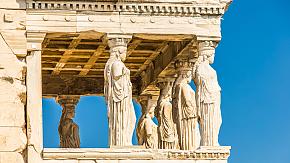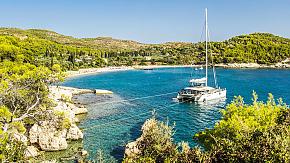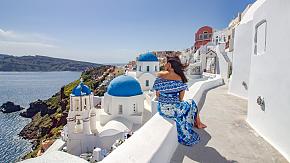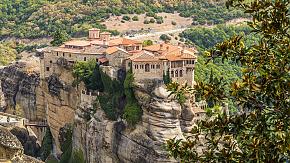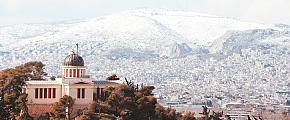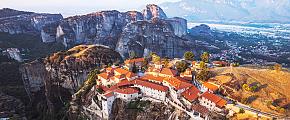Highlights of Greece: What Not to Miss for Your First Visit
Greece isn't just about ancient history and ruins. With a long coastline and many islands, it's a land of beaches - boasting the world's second highest number of "Blue Flag" beaches after Spain. With 18 UNESCO World Heritage sites, Greece is perfect for combining culture and history with beach time. From lively nightlife to peaceful retreats, and even skiing in some areas, it has something for everyone. Here are some highlights of this fascinating and beautiful destination.
Athens
Athens is one of the world's oldest cities, its recorded history going back 3,500 years. Long the most important and largest city in Greece, it only officially became the capital in 1834. It is home to many of the most famous and important sites in Greece.
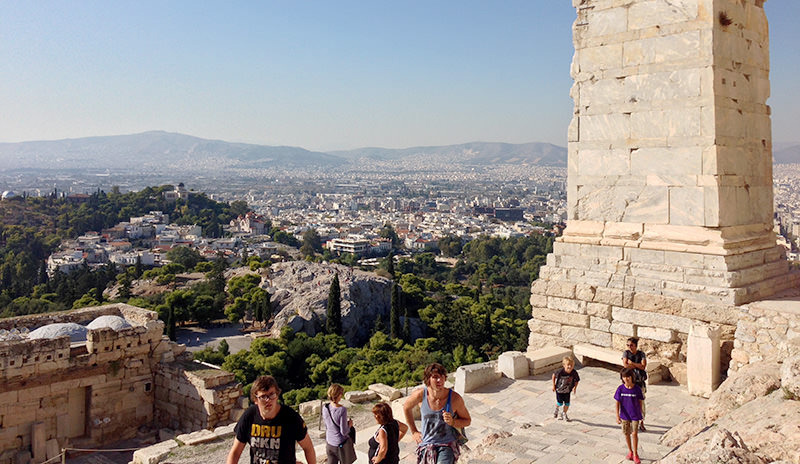 The Acropolis above the city of Athens
The Acropolis above the city of Athens
The Acropolis of Athens, perched 150 m / 490 ft high on a rocky hill overlooking the city, is a large citadel or acropolis. This isn't the only acropolis in Greece, but it is by far the most impressive and well-known, so is usually just referred to just as "The Acropolis". Although there is evidence of the hill being occupied as early as 4,000 BC, what can be seen now are the remains of what was built by Pericles in the 5th century BC. The complex of buildings was dedicated to the goddess Athena, from whom Athens gets its name - or perhaps the goddess takes her name from the city. The experts are divided on that question, although most think the city name came first.
One can climb up to the Acropolis and enter through the Propylaea or 'monumental gate'. This impressive gate wall was the official entrance and security checkpoint for centuries until it was blown up in 1656 when some gunpowder stored there was accidentally ignited. The design of the original central gate, one of five gates in the wall, has inspired other monumental gates around the world, most significantly the Brandenburg Gate in Berlin, Germany.
Once through the gate, most visitors head straight for the acropolis's most important building, the Parthenon, Greece's most iconic building. Built between 447 and 438 BC, this was, like all the Acropolis, dedicated to Athena, but in the 6th century AD briefly became a Christian Church, dedicated to the Virgin Mary. It became a Roman Catholic church again in the 13th century. In the early 1460s, the Ottoman Empire turned it into a mosque. The Parthenon too was badly damaged, not by time, but by another accidental explosion in 1687.
However, arguably the worst damage was done in the 19th century when the Acropolis was basically looted and many of the statues removed, most famously by the British Thomas Bruce, 7th Earl of Elgin, although he claimed to have been given permission by the Ottoman Turks. These are now displayed in the British Museum in London as the "Elgin Marbles", although there are strong calls for them to be returned. Other pilfered statues can be seen in the Louvre in Paris as well as museums around Europe. Many are now housed in the nearby, modern Acropolis Museum along with thousands of artifacts found on the rocky hill. Still, even damaged and stripped of some of its treasure, it remains one of the world's greatest architectural achievements.
Nearby are the remains of the Temple of Athena Nike. Here things get confusing. In most accounts, Athena and Nike were two separate goddesses, Athena being responsible for wisdom, courage, inspiration, civilization, law and justice, strategic warfare, mathematics, strength, strategy, the arts, crafts, and skill. Busy lady. Nike, on the other hand was the goddess of victory. However, sometimes they are treated as being different aspects of the one goddess.
Whatever, the current incarnation of the temple was built in the 19th century to replace the previous one destroyed by the Turks in 1686. There is evidence of a temple on the site back in the 5th century BC. Conservation work is ongoing at the temple, so it is regularly closed to visitors, although it can always still be admired from the outside.
Before leaving the Acropolis, we must mention the Erechtheion, another temple on the Acropolis this time dedicated to both Athena and Poseidon, God of the Sea among his other responsibilities. Don't miss the unusual Porch of the Caryatids, also known as the Porch of the Maidens, whose six columns are in the form of female figures. Those you will see are replicas. Lord Elgin stole one of the originals to decorate his Scottish mansion and it is now in the British Museum. The other five are in the Acropolis Museum.
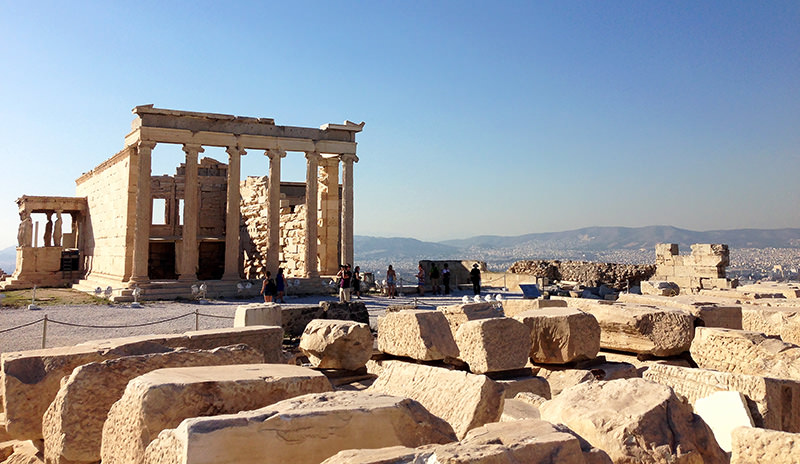 Erechtheion, an ancient Greek temple on the Acropolis of Athens
Erechtheion, an ancient Greek temple on the Acropolis of Athens
In 520 BC, the then Greek leaders decided to build the largest temple in the world, the Temple of Olympian Zeus and dedicate it to Zeus, the God of the Sky and King of the Gods who lived on Mount Olympus. They chose a prime site at the foot of the Acropolis in the center of Athens. Ten years later work was abandoned for political reasons and the barely started construction lay ignored for around 300 years. Sporadic attempts to revive the project did very little until the time of the Roman Emperor, Hadrian who finally oversaw the completion of the work. To celebrate, a huge statue of Hadrian was built behind the temple, but that was outdone by the even huger statue of Zeus which was inside the temple.
The temple only enjoyed about 100 years of glory until it was abandoned and much of its stone was used for other projects. Of the original 104 columns, only 16 remain and one of those is lying on its side after falling over in a storm. Yet the power and majesty are somehow still there.
Delphi
182 km / 113 miles northwest of Athens, on the south-western slope of Mount Parnassus, is Delphi, home to the Sybil or Oracle of Delphi. According to the Greek myths, Zeus determined to locate the center of the earth by sending two eagles to find it, one flying east and the other west. In time, their paths crossed over what is now Delphi. Obviously, this must be the center of the earth and so the city was founded.
Today, you can visit the ruins of the Temple of Apollo where the High Priestess, also known as the Sybil gave her prophecies. Also, well worth a visit is the Theater uphill from the temple and in slightly better condition. For photographs, the most popular site is the Tholos of Delphi with its 30 columns, three of which have been restored.
Mount Olympus
The home of the twelve Greek Gods in ancient Greek mythology, Mount Olympus is Greece's highest mountain, standing at 2,917 meters / 9,570 feet. In 1938, the mountain became the country's first National Park and is home to a large variety of fauna and flora. It is a UNESCO-recognized "Biosphere Reserve" and is noted for its bird life. There is a Visitors' Information Center at Litochoro where you can learn all about the mountain, its history, mythology, nature, and more. Guided hikes can also be arranged here.
Contrary to many people's expectations Olympus has no connection with the Olympic Games. These were held far away at:
Olympia
The small town of Olympia was home to the world's best-known sporting tournament, the Olympian Games which were held here every four years between 776 BC–393 AD. It was used again in the 2004 Olympics which were being held in Athens. The Olympic torch is lit here by the sun's rays reflected parabolic mirror at the ruins of the Temple of Hera which was destroyed by an earthquake in the 4th century AD.
You can visit the remains of the Olympic stadium and the gymnasium etc. and see the running track. A must for all sports fans.
Islands
Greece abounds in archaeological sites, not all of which can be covered here, but it is also known for its many islands. It is difficult to say exactly how many there are as some disappear at high tide and some are so tiny that no one can agree whether to count them or not. Estimates vary from as few as 1,200 to as high as 6,000. The vast majority are uninhabited, with only around 200 or so permanently settled.
There are beaches to suit every kind of visitor. Quiet, secluded beaches to noisy nightlife - all can be found here. Some examples include:
Santorini
Santorini is usually touted as being an ideal island for honeymoon couples and is easily accessible from main European airports. The beaches here are composed of volcanic sand and pebbles which is perhaps not so alluring as the white sand beaches elsewhere, but they are much more relaxed and less busy than most. Kamari, Perissa, and Perivolos beaches are considered the best. The island has a small but interesting wine-making tradition, so be sure to sample the local drink.
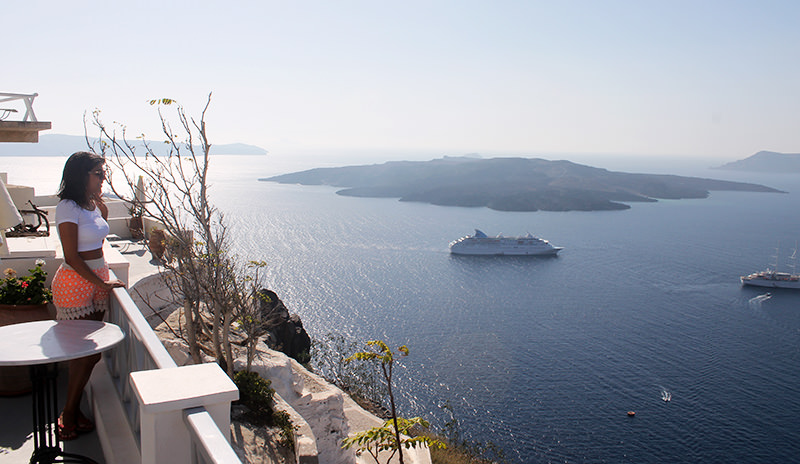 Santorini, an island in the southern Aegean Sea
Santorini, an island in the southern Aegean Sea
Naxos
It has more beaches and is noted for its windsurfing and kite surfing activities, so is well suited to the sportier types. The island also has a number of interesting archaeological sites, which are well worth visiting.
Kos
Kos is a larger island and attracts a younger crowd with its nightclubs and lively bars. The main town, also known as Kos is pretty with its whitewashed buildings and has many hotels and other tourist facilities. Away from the beaches and bar streets, there are a number of churches, mosques, and a couple of castles as well as the remains of an ancient marketplace.
Hydra
Hydra, a small town island with no cars or motorcycles allowed, is known for its artistic community. It is also a popular yachting center. The small town, known as Hydra Port, is easily navigable on foot and has a number of restaurants, bars, markets, etc. The island will be known to many music fans, particularly those from Canada, as it was where Leonard Cohen lived and wrote many of his famous earlier songs, such as "So Long, Marianne".
Mykonos
Sometimes called "Island of the Winds", it is probably Greece's liveliest island. It is known for its nightlife and for its gay-friendly culture. There are a number of beaches and sites of interest. Look out for the famous Mykonos windmills. A lovely spot to visit is Little Venice, where old fishing houses overhang the sea. Today, many of these have been converted into bars and cafés.
These are only a handful of the many islands you could visit. Many travelers like to take ferries on an island hopping adventure, maximizing the number they get to see.
Odynovo can tailor-make an exciting, free itinerary based your preferences and wishes to Greece or any of over thirty destinations worldwide. Just let us know what you want and we'll get back to you within 24 hours.
What Our Clients Say
Explore the latest verified reviews of Odynovo's travel services on Tripadvisor, Google, Trustpilot, Product Review and more trusted platforms.

